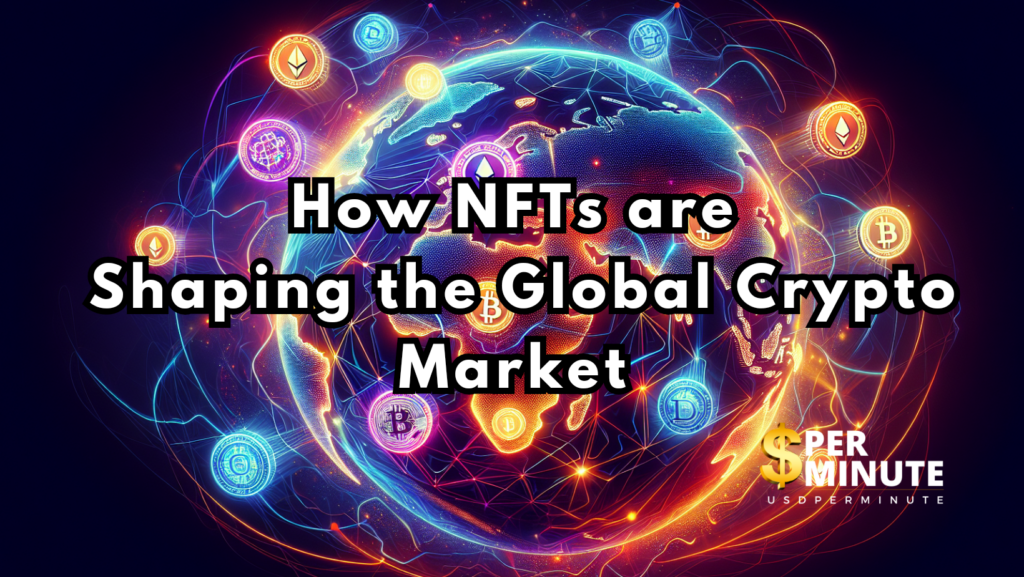How NFTs are Shaping the Global Crypto Market

The rise of Non-Fungible Tokens (NFTs) has revolutionized both the art world and the broader financial landscape. Unlike cryptocurrencies like Bitcoin or Ethereum, which are fungible (interchangeable), NFTs represent unique digital assets that cannot be replaced or duplicated. NFTs have rapidly grown in popularity, affecting the global crypto market in numerous ways. This article explores how NFTs are influencing the crypto ecosystem and what this means for traders, investors, and the market as a whole.
1. NFTs Drive Ethereum Adoption
Most NFTs are built on the Ethereum blockchain using its ERC-721 and ERC-1155 standards, making Ethereum the go-to platform for NFT projects. This has significantly boosted Ethereum’s demand, driving up both its value and usage. As more people mint, buy, and trade NFTs, the demand for Ethereum tokens has surged, which, in turn, pushes transaction fees (or gas fees) higher.
For the Ethereum network, NFTs have brought in new users who may not have been interested in the cryptocurrency space before. This influx of activity helps solidify Ethereum’s position as a leader in blockchain technology, particularly in the realm of smart contracts.
2. Boosting Crypto Market Capitalization
The NFT craze has introduced large sums of money into the cryptocurrency market. In 2021 alone, NFT sales reached billions of dollars, with high-profile transactions like Beeple’s digital artwork selling for $69 million at Christie’s auction house. As a result, the cryptocurrency market has experienced a sharp rise in overall market capitalization.
This injection of liquidity and capital into the market can potentially make cryptocurrencies more stable in the long run. With large sums of money being tied to digital assets, crypto’s market volatility may become less extreme, particularly as more institutional investors get involved in the NFT space.
3. Increasing Blockchain Innovation
The success of NFTs has spurred innovation across various blockchains. Developers are constantly looking for ways to improve scalability, reduce transaction fees, and enhance the user experience for NFT trading. This has led to the rise of Layer 2 solutions and alternative blockchains like Solana, Binance Smart Chain, and Flow, which offer faster and cheaper transactions compared to Ethereum.
NFTs have accelerated the development of cross-chain interoperability, allowing assets to be transferred between different blockchains. As these technologies continue to evolve, they will likely make the broader cryptocurrency ecosystem more efficient and interconnected.
4. New Investment Opportunities
NFTs have opened up entirely new investment avenues. Traditional cryptocurrencies like Bitcoin and Ethereum are primarily used as stores of value or mediums of exchange. NFTs, on the other hand, allow investors to diversify their portfolios by holding unique digital assets that may appreciate in value over time.
High-profile NFTs, including rare collectibles, digital art, and virtual real estate, have become valuable assets. For instance, platforms like Decentraland and The Sandbox allow users to buy virtual land in a decentralized world, which can later be sold for a profit. This adds an entirely new dimension to investing, where digital ownership is verifiable and tradable.
5. Transforming Digital Ownership
NFTs are revolutionizing the concept of ownership in the digital age. In traditional markets, proving ownership of a physical item is straightforward. However, in the digital realm, ownership has often been ambiguous, with files being easily duplicated and shared. NFTs solve this by providing a verifiable way to prove digital ownership via the blockchain.
This has led to a boom in the creation of digital collectibles, music, art, and even real-world assets being tokenized as NFTs. As more industries adopt NFTs, the way we buy, sell, and trade digital assets is changing, further intertwining the worlds of cryptocurrency and digital commerce.
6. Impact on Regulatory Landscape
The growing popularity of NFTs has caught the attention of regulators across the globe. As with any financial innovation, regulators are concerned about fraud, money laundering, and market manipulation within the NFT market. Governments are now exploring ways to regulate NFTs and the broader cryptocurrency market to protect consumers while fostering innovation.
Increased regulation could provide a more secure environment for investors and traders, further legitimizing the NFT space and encouraging more mainstream adoption.
7. Challenges and Criticisms
Despite their rapid growth, NFTs have not been without challenges. Environmental concerns have been a significant issue, as the energy required to mint and trade NFTs, particularly on the Ethereum blockchain, is considerable. This has led to criticism that NFTs are contributing to carbon emissions.
Moreover, the speculative nature of the NFT market has raised concerns about a potential bubble. Some believe that the rapid price increases seen in NFT markets are unsustainable and could lead to significant losses for investors if the bubble bursts.
Conclusion
NFTs are more than just a passing trend; they represent a fundamental shift in how we view digital ownership, trade, and investment. By integrating with the broader crypto market, NFTs have driven the adoption of cryptocurrencies like Ethereum, boosted market capitalization, and introduced new investment opportunities.
However, the NFT market is still in its infancy and faces challenges like environmental concerns and regulatory scrutiny. As the market matures, NFTs will likely continue to shape the future of the global crypto market, offering innovative ways to own, trade, and interact with digital assets.